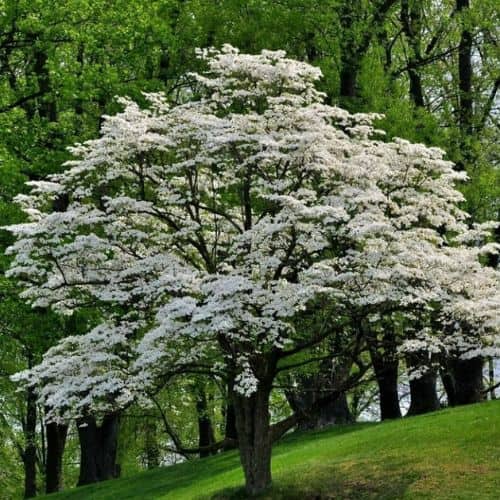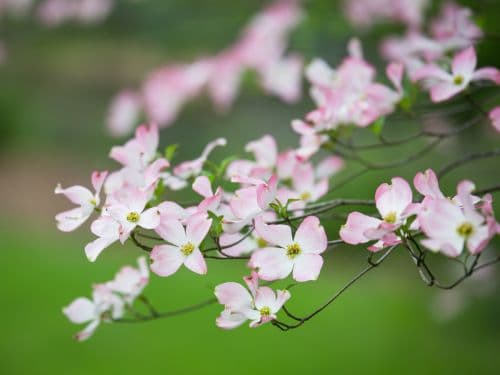The Dogwood stands as a symbol of grace and is sought out for its delicate flowers, distinctive branching pattern, and vibrant foliage. Belonging to the Cornus genus, Dogwoods are revered for their stunning springtime blossoms that showcase a profusion of delicate flowers in white, pink, or red shades. These trees are perfect for those who seek to cultivate more than just a tree, but a living testament to the changing seasons.

Growing and Caring for Dogwood Trees
Dogwood trees thrive in well-drained, slightly acidic soil rich in organic matter. When planting Dogwoods, choose a location with filtered sunlight or partial shade, as they prefer protection from the harsh midday sun. Watering plays a pivotal role in the early stages of Dogwood tree establishment; consistent moisture fosters a robust root system, especially during dry spells.
Dogwoods are known for their shallow root systems, necessitating a layer of mulch to retain moisture, regulate soil temperature, and discourage competing weeds. Pruning is another essential aspect of caring for Dogwood trees. Remove dead or diseased branches to encourage air circulation and maintain the tree’s overall health. Regular monitoring for pests and diseases ensures early detection and effective intervention, as Dogwoods can be susceptible to issues like powdery mildew and dogwood anthracnose.
Size, Shape, and Growth Rate
The most common Dogwood species, Cornus florida, typically reaches 15 to 30 feet, creating a moderate-sized tree suitable for various landscapes. The overall shape of the Dogwood tree is rounded to horizontally spreading, forming a graceful silhouette that evolves with the changing seasons.
The growth rate of Dogwood trees is moderate, ensuring steady development without overwhelming the surrounding landscape. While the initial years may witness a more vigorous growth phase, the tree settles into a more deliberate pace as it matures. This measured growth rate allows gardeners to plan strategically, providing ample time for the tree to establish itself and showcase its captivating features without becoming unwieldy.
Branches, Leaves, and Flowers
Dogwood trees are renowned for their distinctive branching pattern. The horizontal branching creates an elegant layered effect, emphasizing the tree’s graceful form. When the leaves have fallen in winter, the branching structure becomes even more pronounced, adding interest to the winter garden.
The leaves of Dogwood trees contrast with the branches, transitioning through a spectrum of colors throughout the seasons. In spring, the foliage emerges in a fresh green hue, providing a lush backdrop for the star attraction – the flowers. As summer arrives, the leaves mature into a deeper green, offering a rich and verdant canvas. Come fall, Dogwood leaves undergo a breathtaking transformation, showcasing shades of red, purple, and burgundy, creating a vivid display that rivals the most vibrant autumnal landscapes.
The glory of Dogwood trees is undoubtedly their flowers. In late spring, Dogwoods burst into a profusion of blossoms. The flowers are typically four-petaled and arranged in clusters, ranging from white and pink to shades of red. These delicate blooms often likened to the appearance of a butterfly in flight, lend an ethereal quality to the landscape. Dogwood flowers also attract pollinators, including bees and butterflies, contributing to the garden’s biodiversity.

Uses in the Garden
When planted as specimen trees, they command attention with their elegant form, distinctive branching, and seasonal transformations. The versatility of Dogwoods shines in mixed borders, where their layered structure complements a variety of companion plants, creating dynamic and visually engaging compositions. Additionally, Dogwoods excel in creating natural screens or boundaries within the garden. Their horizontally spreading branches provide effective coverage, offering privacy while adding a touch of sophistication to outdoor spaces.
Compact varieties of Dogwood, such as Cornus sericea ‘Flaviramea,’ are well-suited to informal hedges, contributing both structure and color to the garden. Dogwood trees are also favored for their ability to thrive in woodland or naturalized settings. Planted alongside other native species, they enhance the ecological balance of the landscape, providing habitat and food sources for local wildlife.
Frequently Asked Questions
Is My Dogwood Tree Dead?
Determining if a dogwood tree is dead can depend on several factors, including the tree’s appearance, the condition of its branches and bark, and the time of year. Here are some signs to look for:
- In spring, a healthy dogwood tree should produce new leaves. If it’s late spring or summer and there are no signs of new leaves despite appropriate growing conditions, it could indicate a problem.
- Check the branches for signs of life. Healthy branches should be flexible and show signs of green beneath the bark when scratched. Dead branches may be brittle, dry, and devoid of green tissue.
- Healthy dogwood trees have smooth, intact bark. Peeling, cracked, or damaged bark may indicate underlying issues. However, some dogwood species have naturally exfoliating bark, so it’s essential to know the characteristics of the specific variety.
- Examine the roots if possible. Healthy roots should be firm and white. Mushy or dark-colored roots could indicate rot or disease.
Do Deer Like Dogwood Trees?
In general, dogwood trees are considered to have some level of resistance to deer browsing compared to other plants. Dogwood leaves, bark, and branches are not favored by deer due to their bitter taste and low nutritional value. However, deer may occasionally nibble on young shoots or leaves of dogwood trees, especially if other food sources are scarce or during periods of high deer populations.
Do Dogwoods Smell Bad?
Dogwood trees themselves do not have a strong or unpleasant odor associated with them. Many people appreciate the sweet fragrance of dogwood flowers, which can vary depending on the species and cultivar. The flowers of some dogwood species, such as Cornus florida (flowering dogwood), have a mild, pleasant scent that some people compare to a light perfume. Other species, such as Cornus kousa (kousa dogwood), may have a slightly different fragrance, but it is still generally considered pleasant.
